Related Research Articles

The East India Company (EIC), also known as the Honourable East India Company (HEIC), East India Trading Company (EITC), the English East India Company or the British East India Company, and informally known as John Company, Company Bahadur, or simply The Company was an English and later British joint-stock company founded in 1600. It was formed to trade in the Indian Ocean region, initially with the East Indies, and later with Qing China. The company seized control of large parts of the Indian subcontinent, colonised parts of Southeast Asia and Hong Kong after the First Opium War, and maintained trading posts and colonies in the Persian Gulf Residencies.

Vasco da Gama, 1st Count of Vidigueira, was a Portuguese explorer and the first European to reach India by sea.
William Baffin was an English navigator and explorer. He is primarily known for his attempt to discover a Northwest Passage from the Atlantic to the Pacific, during the course of which he was the first European to discover Baffin Bay in present-day Canada. He was also responsible for exceptional surveys of the Red Sea and Persian Gulf on behalf of the East India Company.

William Adams, known in Japanese as Miura Anjin, was an English navigator who, in 1600, was the first Englishman to reach Japan leading a five-ship expedition for a private Dutch fleet. Of the few survivors of the only ship that reached Japan, Adams and his second mate Jan Joosten were not allowed to leave the country while Jacob Quaeckernaeck and Melchior van Santvoort were permitted to go back to the Dutch Republic to invite them to trade.
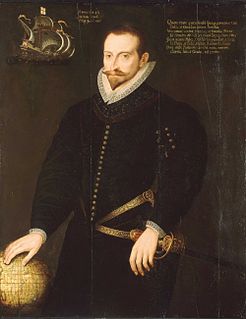
Sir James Lancaster VI was a prominent Elizabethan trader and privateer.
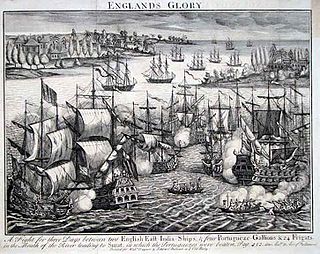
The naval Battle of Swally, also known as Battle of Suvali, took place on 29–30 November 1612 off the coast of Suvali a village near the Surat city and was a victory for four English East India Company galleons over four Portuguese galleons and 26 barks.
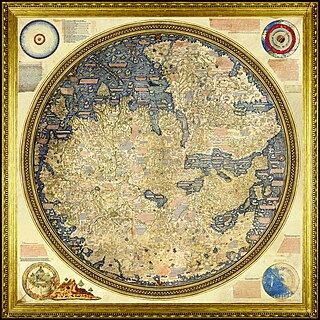
This is a chronology of the early European exploration of Asia.
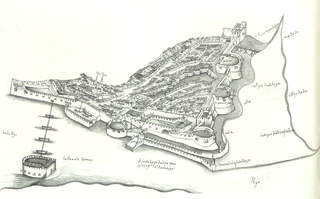
The siege of Diu occurred when an army of the Sultanate of Gujarat under Khadjar Safar, aided by forces of the Ottoman Empire, attempted to capture the city of Diu in 1538, then held by the Portuguese. The Portuguese successfully resisted the four months long siege. It is part of The Ottoman-Portuguese War.
John Weddell (1583–1642) was an English sea captain who served for both the Muscovy Company and the East India Company (EIC).

Scourge of Malice or Malice Scourge or Mare Scourge was a 38-gun ship ordered by George Clifford, 3rd Earl of Cumberland. She was built and launched at Deptford Dockyard in 1595. The Earl used her as his flagship during raids on the Spanish Main, where she provided additional force to support his fleet. She was later renamed Red Dragon; the East India Company used her for at least five voyages to the East Indies. The first recorded performance of the play Hamlet took place on Red Dragon in 1607 while she was anchored off the coast of Sierra Leone.

Sir Henry Middleton was a sea captain and adventurer. He negotiated with the sultan of Ternate and the sultan of Tidore, competed against Dutch and Portuguese interests in the East Indies but still managed to buy cloves. He had two brothers, John Middleton, the eldest who was captain of EIC galleon Hector and director of EIC. David Middleton was also a mariner working for EIC.
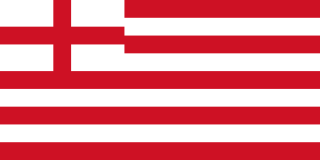
Bantam Presidency was a presidency established by the British East India Company and based at the Company factory at Bantam in Java. Founded in 1617, the Presidency exercised its authority over all the Company factories in India, including the agencies of Madras, Masulipatnam and Surat. The factors at Bantam were instrumental in founding the colony of Madraspatnam in 1639 with the Fort St. George, which later grew into the modern city of Madras. The Presidency of Bantam was twice downgraded, first in 1630 before being restored in 1634 and for the second time in 1653, when owing to the hostility of Dutch traders, the Presidency was shifted to Madras.
William Hawkins was a representative of the English East India Company notable for being the commander of Hector, the first company ship to anchor at Surat in India on 24 August 1608. Hawkins travelled to Agra to negotiate consent for a factory from Emperor Jahangir in 1609.
David Middleton was a merchant and sea-captain in the service of the English East India Company who made several voyages by sea to the Far East.
Alexander Sharpeigh, was an English merchant and sea-captain.
Thomas Best (1570?–1638?), was a captain for the English East India Company and later the Royal Navy.
Gabriel Towerson, was a captain and agent for the East India Company.
John Jourdain, was a captain in the service of the English East India Company (EIC), and the first president of the EIC Council of India
Andrew Shilling, was a naval commander in the fleet of the English East India Company (EIC).
The Mughal Empire's province Gujarat to the west of the Indian peninsula, was managed by the Viceroys appointed by the emperors. The emperor Jehangir continued Mírza Âzíz Kokaltásh as the viceroy when he ascended to the throne in 1605. He continued to manage the province even though Khalij Khan was appointed as the new viceroy. He was succeeded by Sayad Murtaza who controlled the rebellions in north and south Gujarat. Mírza Âzíz Kokaltásh again returned as the viceroy and successfully averted invasion of Malik Ambar from Daulatabad in south. The next viceroy Abdulláh Khán Fírúz Jang made expedition to south and subdued the Ahmednagar. During his time, in 1611, Jehangir permitted the British East India Company to establish factories in Surat and elsewhere in Gujarat. During the reign of the next viceroy Mukarrab Khán, Jehangir toured Gujarat and received several local rulers. In 1618, he appointed his son prince Shah Jahan as the next viceroy. He rebelled in 1622–23 and he was replaced by Sultán Dáwar Baksh. Shah Jahan resisted but later he managed the Jehangir's new appointment, Khán Jahán as his own. Saif Khan had managed the province instead as Khan Jahan was sent as Shah Jahan's ambassador to Jehangir. Jehangir died and Shah Jahan succeeded him as the emperor in 1627.
References
- ↑ Foster 1939, p. xiii–xiv.
- ↑ East India Company (1897). List of factory records of the late East India Company: preserved in the Record Department of the India Office, London. p. vii.
- ↑ Foster 1939, p. xvi.
- ↑ Foster 1939, p. 75.
- ↑ Tirthankar, Roy (2016). The East India Company: The World's Most Powerful Corporation. Penguin Books Limited. p. 46. ISBN 978-81-8475-613-5.
- Bibliography
- Foster, William, ed. (1939). The Voyage of Nicholas Downton to the East Indies 1614–15 as recorded in Contemporary Narratives and Letters. London: Hakluyt Society.
- Attribution
![]() This article incorporates text from a publication now in the public domain : "Downton, Nicholas". Dictionary of National Biography . London: Smith, Elder & Co. 1885–1900.
This article incorporates text from a publication now in the public domain : "Downton, Nicholas". Dictionary of National Biography . London: Smith, Elder & Co. 1885–1900.